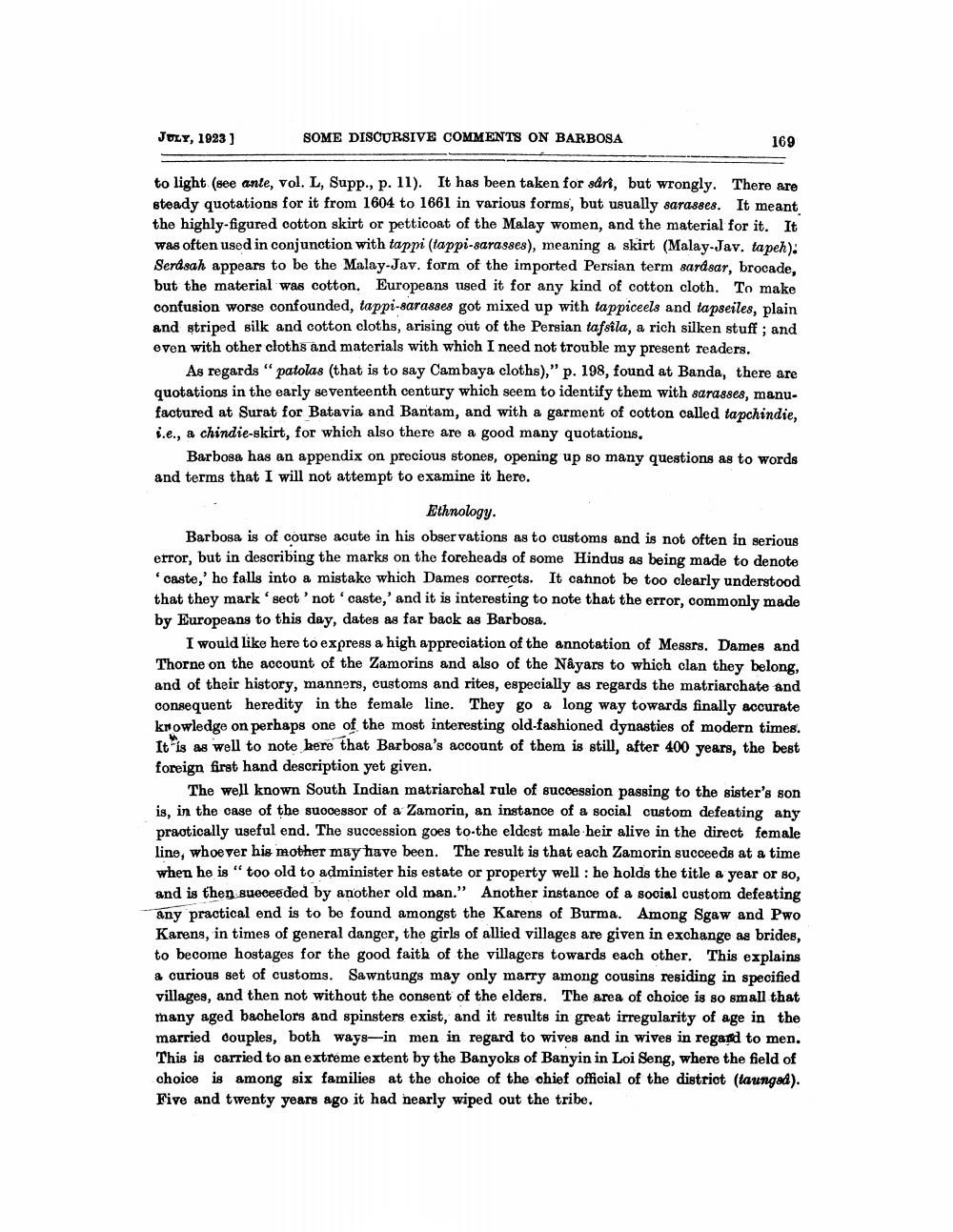________________
JULY, 1923)
SOME DISCURSIVE COMMENTS ON BARBOSA
169
to light (see ante, vol. L, Supp., p. 11). It has been taken for sårt, but wrongly. There are steady quotations for it from 1604 to 1661 in various forms, but usually sarasses. It meant the highly-figured cotton skirt or petticoat of the Malay women, and the material for it. It was often used in conjunction with tappi (tappi-sarasses), meaning a skirt (Malay-Jav, ta peh). Serdsah appears to be the Malay-Jav. form of the imported Persian term sardsar, brocade, but the material was cotton. Europeans used it for any kind of cotton cloth. To make confusion worse confounded, tappi-sarasses got mixed up with tappiceels and tapseiles, plain and striped silk and cotton cloths, arising out of the Persian tafsila, a rich silken stuff ; and even with other cloths and materials with which I need not trouble my present readers.
As regards "patolas (that is to say Cambaya cloths),” p. 198, found at Banda, there are quotations in the early seventeenth century which seem to identify them with sarasses, manufactured at Surat for Batavia and Bantam, and with a garment of cotton called tapchindie, i.e., a chindie-skirt, for which also there are a good many quotations,
Barbosa has an appendix on precious stones, opening up so many questions as to words and terms that I will not attempt to examine it here.
Ethnology. Barbosa is of course acute in his observations as to customs and is not often in serious error, but in describing the marks on the foreheads of some Hindus as being made to denote
caste,' he falls into a mistake which Dames corrects. It cannot be too clearly understood that they mark' sect' not caste,' and it is interesting to note that the error, commonly made by Europeans to this day, dates as far back as Barbosa.
I would like here to express a high appreciation of the annotation of Messrs. Dames and Thorne on the account of the Zamorins and also of the Nayars to which clan they belong, and of their history, manners, customs and rites, especially as regards the matriarchate and consequent heredity in the female line. They go a long way towards finally accurate krowledge on perhaps one of the most interesting old-fashioned dynasties of modern times. It is as well to note here that Barbosa's account of them is still, after 400 years, the best foreign first hand description yet given.
The well known South Indian matriarchal rule of succession passing to the sister's son is in the case of the successor of a Zamorin, an instance of a social custom defeating any practically useful end. The succession goes to the eldest male heir alive in the direct female line, whoever his mother may have been. The result is that each Zamorin succeeds at a time when he is "too old to administer his estate or property well : he holds the title a year or so, and is then succeeded by another old man.” Another instance of a social custom defeating any practical end is to be found amongst the Karens of Burma. Among Sgaw and Pwo Karens, in times of general danger, the girls of allied villages are given in exchange as brides, to become hostages for the good faith of the villagers towards each other. This explains a curious set of customs. Sawntungs may only marry among cousins residing in specified villages, and then not without the consent of the elders. The area of choioe is so small that many aged bachelors and spinsters exist, and it results in great irregularity of age in the married couples, both ways--in men in regard to wives and in wives in regard to men. This is carried to an extreme extent by the Banyoks of Banyin in Loi Seng, where the field of choice is among six families at the choice of the chief official of the distriot (taungad). Five and twenty years ago it had nearly wiped out the tribe.




